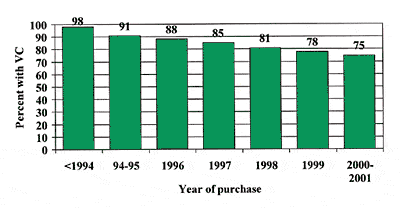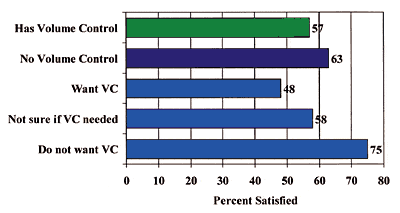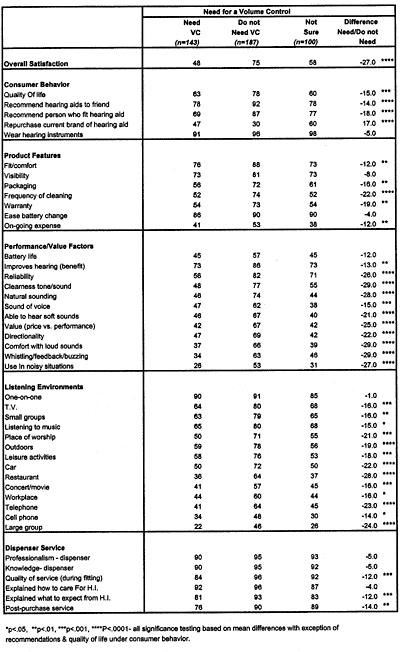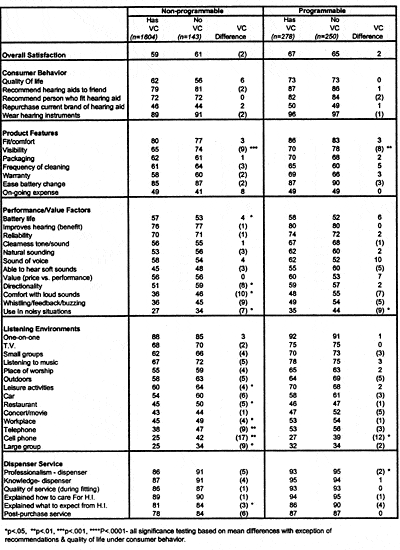The strategic movement toward automatic hearing instruments is a positive trend—one that will ultimately make the hearing instrument experience more natural and pleasant for the consumer. However, categorical removal of instrument controls, particularly volume controls (VCs), has undoubtedly led to unnecessary frustration and anger among some consumer segments. Clearly consumer feedback on this issue is critical in developing a more refined segmentation and counseling strategy (eg, in determining who gets the controls and who does not).
Increased market penetration by completely-in-the-canal (CIC) and all styles of digital signal processing (DSP) hearing instruments has led to a decline in the sales of hearing instruments with manual volume controls (VCs). Market statistics do not exist with respect to the number of hearing instruments sold in the US that do not offer a volume control. However, a reasonable estimate can be ascertained by querying the MarkeTrak VI panel. As shown in Figure 1, manual volume control penetration declined from 98% prior to 1994 to 75% in the spring of 2001 and 2000.

Figure 1. Percent of in-the-ear hearing instruments (ie, ITE,
ITC, and CIC styles) with volume controls by year of purchase
(MarkeTrak VI, n = 2,352).
In four previous studies,1-4 the following has been demonstrated:
- Approximately one-third of consumers without a VC desire one;
- The difference in overall customer satisfaction ratings between consumers who “need a VC” and consumers “who do not need a VC” have been documented as high as 40% (experienced users in MarkeTrak VI);
- Use of a VC is rated as a highly desirable hearing instrument feature by 78% of US consumers.
- Hearing instruments, which are “easier to regulate (volume)” are on the wish list of 72% of US consumers and 65% of German consumers.
In my discussions with industry leaders on this topic, there have been four reoccurring, intriguing theories concerning MarkeTrak data on VCs. First, they question whether the differential in customer satisfaction ratings by those who want and those who do not want a volume control is related to the experience of the users; it has been hypothesized that experienced users will be less likely to want to give up the manual volume control. Second, a number of people have voiced the opinion that the large differentials observed may have nothing to do with the presence or absence of the volume control; perhaps the consumer simply received poor benefit from the hearing instrument and used the volume control as a “scapegoat” under the assumption that the presence of a volume control would have assured them a hearing instrument that provided them with more benefit. Third, dispensing professionals and consumers have reported that automatic hearing aids work well but not in 100% of listening situations, and that the presence of a volume control acts as a manual override (eg, making soft sounds more audible, reducing the aversiveness of noise or loud sounds). Supporting this premise is the fact that only 42% of consumers are satisfied with loudness comfort. Fourth, there may be segments of users who psychologically must be in control of their hearing instruments and not the “prisoner of a signal processing strategy” and its associated automatic gain control.
This paper, the fifth in the MarkeTrak VI series, will attempt to isolate the possible impact of removal of the manual volume control on customer satisfaction and shed light on some of the above issues.
Method
In previous MarkeTrak publications,1 I presented a detailed methodology, and readers are encouraged to review the methods in the first article in this series (December 2001 HR). Since incidence of hearing instruments without manual volume controls has been historically low, I have combined the survey responses of MarkeTrak V (1997) and MarkeTrak VI (2000-2001) hearing instrument owners concentrating on in-the-ear (ITE) hearing instruments, which were less than six years of age (the sample size for BTEs without VCs was too small to be reliable). This resulted in sample sizes of 2,397 with volume controls and 446 without volume controls.
Comparisons of customer satisfaction rating profiles for consumer segments with and without volume controls are presented in Tables 1-4. In Table 5, using analysis of co-variance (ANCOVA), I concurrently analyze the impact of the VC, style (size of instrument), technology, as well as user level by VC interaction (eg, experienced users react differently to the absence of a VC) while controlling for degree of hearing loss as a means of isolating the possible impact that the lack of a VC might have on customer satisfaction ratings.
Results & Discussion
Consumers are specifically asked, “Does your hearing aid have a volume control enabling you to adjust the volume on your hearing aid?.” If the consumer indicates “No,” the questionnaire asks, “Would you prefer if your hearing aid had a volume control?”

Figure 2. Overall customer satisfaction based on the presence
of a volume control and the desire for a volume control when
it is missing.
The overall customer satisfaction results are graphed in Figure 2. Consumers with volume controls, on average report lower customer satisfaction ratings than individuals without a volume control (57% versus 63%). However, if results for the “no volume control” group are further segmented based on desire/need (yes, no, not sure) for a VC, there is a large differential between those who want a VC (48% satisfied) and those who indicate they do not need a VC (75% satisfied). “Not sure” consumers report a 58% satisfaction.
Referring to Table 1, the complete MarkeTrak survey profile for these three segments are reported, including differentials between the “need a VC” and the “do not need a VC” segments. It is evident that consumers who believe they need a VC are more dissatisfied with nearly every aspect of their hearing aid—including a host of factors generally not associated with volume control function. In essence, the scope and magnitude of the differentials point to a segment of consumers who are simply dissatisfied with the total hearing instrument experience. When a hearing instrument does not work according to the consumer’s expectations (eg, they did not derive the benefit they need) and they have no ability to control the hearing instrument, then conceivably the consumer is even more angry or disappointed in their hearing instrument than if they had a volume control.

Table 1. Customer satisfaction as a function of stated need for
a volume control (n = 430 ITE/ITC consumers with no volume
control from MarkeTrak V [1997] and MarkeTrak VI [2001]).
In Table 2, customer satisfaction results are shown for all ITE instruments, ITE instruments (full concha, half shell), and for ITC/CIC hearing instruments. Because there are a number of significant findings, it is useful to concentrate on those which are both practical with respect to fitting hearing instruments and statistically significant—that is factors with differentials of at least 10% points.

Table 2. Customer satisfaction with in-the-ear hearing instruments with
and without volume controls (MarkeTrak V & VI, hearing aids less than
6 years of age).
With respect to product features, the presence of a VC negatively impacts ratings of visibility if the hearing instrument is an ITC device but not if it is an ITE device (since the instrument is already quite visible). Across the two hearing instrument styles, the presence of a VC would appear to be associated with lower ratings on important performance factors such as comfort with loud sounds, whistling/feedback/buzzing, and use in noisy situations. Consequently, this translates into lower satisfaction in a number of listening situations, especially outdoors, on the telephone (less so for ITE users because of a probable telecoil switch), and with cell phones. ITC users report significantly lower quality of life ratings if their hearing instruments have a VC.
In Table 3 results are presented for new and experienced users. Contrary to our earlier hypothesis, the experienced user is less likely to rate their hearing instrument lower if it is lacking a volume control, while the new user differential is 12 customer satisfaction points (63% without VC versus 51% with VC). For both experienced and new users the VC would appear to negatively impact comfort with loud sounds, whistling/feedback/ buzzing, use in noisy situations, and performance on the telephone or cell phone. The new user is more likely to react negatively to hearing instruments with VCs, probably because the presence of a VC is associated with the size of the hearing instrument; the smaller the size the greater the new user acceptance of the hearing instrument. The presence or absence of the VC does not impact ratings of visibility for experienced users, presumably because they have already come to terms with the stigma of their own hearing loss.

Table 3. Customer satisfaction with in-the-ear hearing
instruments with and without volume controls; new versus
experienced users (MarkeTrak V & VI, hearing aids less than
6 years of age).
One would expect an interaction between signal processing technology and the volume control. That is, instruments with advanced technology (DSP, non-linear programmable, WDRC, etc.) should perform better than low-tech instruments when the volume control is taken off, conceivably because the advanced technology should reduce the need for the consumer to manually adjust their instrument when moving between listening environments (eg, phone, quiet, noisy restaurant). In MarkeTrak, we ask consumers to tell us if their hearing instrument is programmable or fully digital. The sample size is too small to report on DSP hearing instruments; thus DSP instruments have been combined with “programmable” instruments. Comparisons between programmable (proxy for advanced signal processing) and non-programmable hearing instruments are shown in Table 4. The same pattern is present, though it is less evident then previous segment comparisons. Comfort with loud sounds, telephone/cellphone usage, and use in large groups are negatively impacted by volume controls (or consumer adjustments to the volume control). The programmable users improved by approximately 10 customer satisfaction points on factors previously shown to be negatively related to the volume control, the exception being cell phone usage.

Table 4. Customer satisfaction with in-the-ear hearing
instruments with and without volume controls by technology
(MarkeTrak V & VI, hearing aids less than 6 years of age).
In order to isolate the possible impact of the presence or absence of the volume control, analysis of covariance (ANCOVA) was used. In ANCOVA, the simultaneous impact of the VC, technology, hearing loss, hearing instrument size, and experience can be evaluated by determining its proportional worth/contribution to customer satisfaction. Table 5 presents the results for three hearing instrument features (VC, technology, size), as well as possible divergent user reactions to the VC. The blue bars represent positive contributions and the red bars represent negative contributions to overall satisfaction. The VC—when independent of technology, hearing aid size, hearing loss, and experience—would appear to have a negative impact on comfort with loud sounds, use in noisy situations, and on the cell phone. There is some evidence that the lack of a VC positively impacts battery life.
As previous MarkeTrak studies have shown, advanced technology and smaller (eg, CIC) hearing instruments have had a positive impact on customer satisfaction. There is strong evidence (the fourth column in Table 5) that experienced users are more likely than new users to derive a positive benefit (whether real or perceived) from the volume control. They are more likely to wear their hearing instrument more if it has a VC (while the opposite is true of new users), and they are more likely to rate their overall hearing instrument experience more positively. Specifically they give higher ratings on benefit (“improved hearing”), reliability, sound quality (clearness of tone, natural sounding, sound of voice), and value (performance vs price). Furthermore, they are more likely to rate some listening situations more positively if they possess the “manual override” feature of a VC: listening to music, leisure activities, riding in a car, listening to a concert or movie, and in the workplace.

Table 5. Isolating the influence of the volume control on customer
satisfaction (MarkeTrak V & VI; hearing aids <6 years of age) using least-square-means. Blue bars mean the hearing instrument feature has a
positive influence on customer satisfaction, while the red bars mean the
factor has a negative influence. (Note: The shortest bar indicates the F
value from the Analysis of Variance was significant at the p<0.05 level,
while the longest bar indicates it was significant at the p<0.0001 level.
Interaction of experience and VC means experienced users rated the
presence of a VC more positive than when absent OR experienced users
rated the VC more positively than new users.)
The latter information is likely to confirm dispensing professionals’ ideas about experienced users and VCs. Anecdotally, I have a family member who has been a hearing aid wearer for more than 20 years, and now wears two programmable directional hearing instruments. He swears they are the best hearing instruments he has ever had; his spouse is even more thankful. In general, he indicates the default gain is perfect in most situations. Occasionally there are some situations where the gain is either too soft (the opera for him) or too loud and he does appreciate the ability of adjusting the gain with either his remote control (which he does not like to carry) or the VCs on the instruments. I have heard stories from professional associates who have experienced the wrath of consumers frustrated by their inability to adjust their hearing instrument; and I personally have received phone calls from consumers indicating they would “never purchase a hearing instrument without controls.”
Conclusions
Idealistically, the goal is to provide hearing instruments (or personal communication systems) that are so smart that they never need adjustment. This personal communication system should efficiently determine the volume the consumer needs and adjust its directionality by sensing if the individual is in quiet or a myriad of noisy situations. It is true that consumers do not like to fiddle with their hearing instruments in order to adjust optimally to changing listening environments. Completely digital hearing aids, when in the presence of steady state noise like in an airplane cabin or an air conditioner, should improve the consumer’s hearing comfort in these situations by making these loud and annoying sounds more tolerable. In addition, hearing instruments should not provide annoying feedback (whistling, buzzing or squealing) as they amplify sounds around the consumer. Hearing instruments and assistive devices should restore (or partially restore) the consumer’s ability to enjoy some soft sounds (eg, leaves rustling, bubbling of a fish tank, etc) while sensing very loud sounds and making them comfortable; loud sounds should never be painful to a consumer’s ears.
Although the hearing industry has made commendable progress in producing automatic hearing instruments, we need to ask ourselves if current automatic instruments are so perfect in comprehending a consumer’s listening needs that a manual override will never be needed. By removing the consumer’s ability to control their listening experience, there is an implied assumption that the signal processing strategies are indeed “perfect.” And, if we are wrong (ie, wrong enough times in the opinion of hearing aid users), then we invite unnecessary consumer frustration, resulting in lower than expected satisfaction with hearing care products and services.
Some people need to control or adjust their hearing instruments either manually or with a remote control. Research has shown—especially among experienced wearers—that roughly a third of hearing instrument users still need either a volume control, multiple memory switch (eg, “quiet” versus “noisy situation” switch), or a remote control in order to manipulate volume and/or to access different hearing aid strategies for handling different listening environments. In a study of 79 experienced hearing instrument users, Surr et al.5 found that 77% desired a VC even though the majority used the VC only “seldom” or “occasionally.”
In general, people need control of their hearing instrument for the following reasons:
- The automatic feature does not fully meet their needs in 100% of listening situations;
- Psychologically, they simply have a strong desire to control their hearing aids; or
- They are long-term hearing aid wearers who are used to a volume control and are unwilling to part with it through habit.
It is important that the dispensing professional precisely determine the consumer’s needs with respect to control of the hearing aid. It is true that consumers do not want to fiddle with their hearing aids every 10 minutes; automatic hearing instruments hold the promise of relieving the consumer of that burden. However, categorically removing user controls under the assumption that hearing instruments perfectly comprehend all of the consumer’s desires leads unquestionably to consumer frustration and therefore lower customer satisfaction ratings (especially for experienced users).
Clearly, it is in the best interests of the industry and hearing care professionals to understand more about the issue of consumer needs as they pertain to hearing instrument controls. It is my hope that manufacturers and hearing scientists will convene focus groups with consumers who have experienced hearing instruments with and without controls. This may lead to improved consumer segmentation and counseling strategies, resulting in improved customer satisfaction with hearing instruments.

|
Correspondence can be addressed to HR or Sergei Kochkin, PhD, Knowles Electronics, 1151 Maplewood Dr., Itasca, IL 60143; email: [email protected].
References
1. Kochkin S. MarkeTrak VI: 10-year customer satisfaction trends in the U.S. hearing instrument market, The Hearing Review. 2002; 9(10):14-25, 46.
2. Kochkin, S. MarkeTrak VI: Consumers rate improvements sought in hearing instruments. Hearing Review. 2002; 9(11):18-22.
3. Kochkin S. Customer satisfaction with single and multiple microphone digital hearing aids. Hearing Review. 2000; 7(11):24-29.
4. Kochkin S. MarkeTrak V: Customer satisfaction revisited. Hearing Jour. 2000; 53(1): 38-55.
5. Surr RK, Cord MT, Walden BE. Response of hearing aid wearers to the absence of a user-operated volume control. Hear Jour. 2001; 54(4):32-36.





